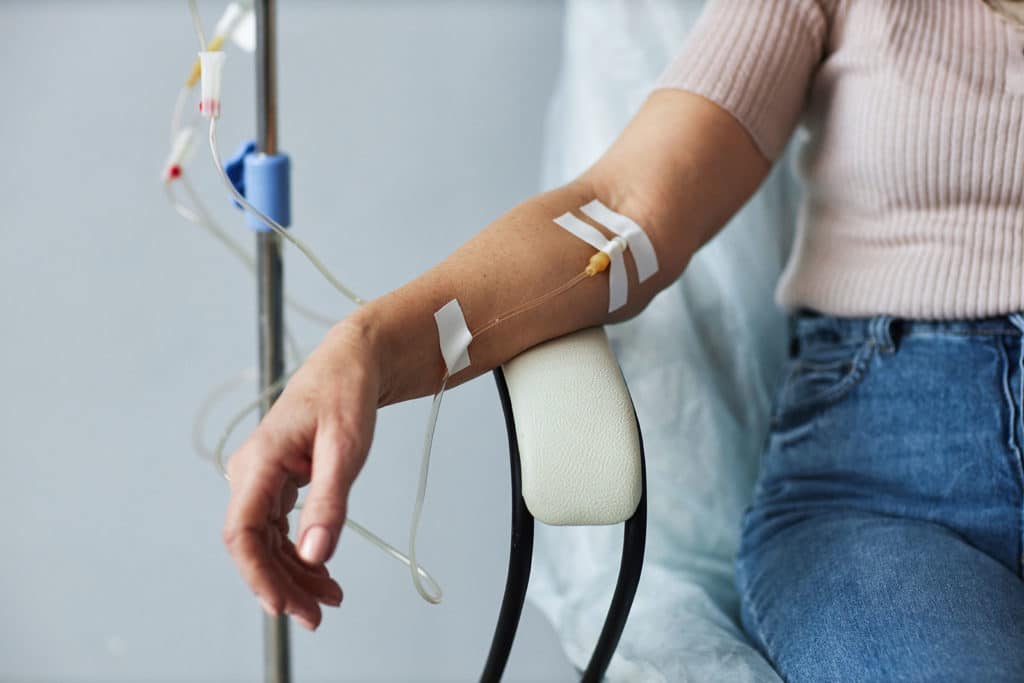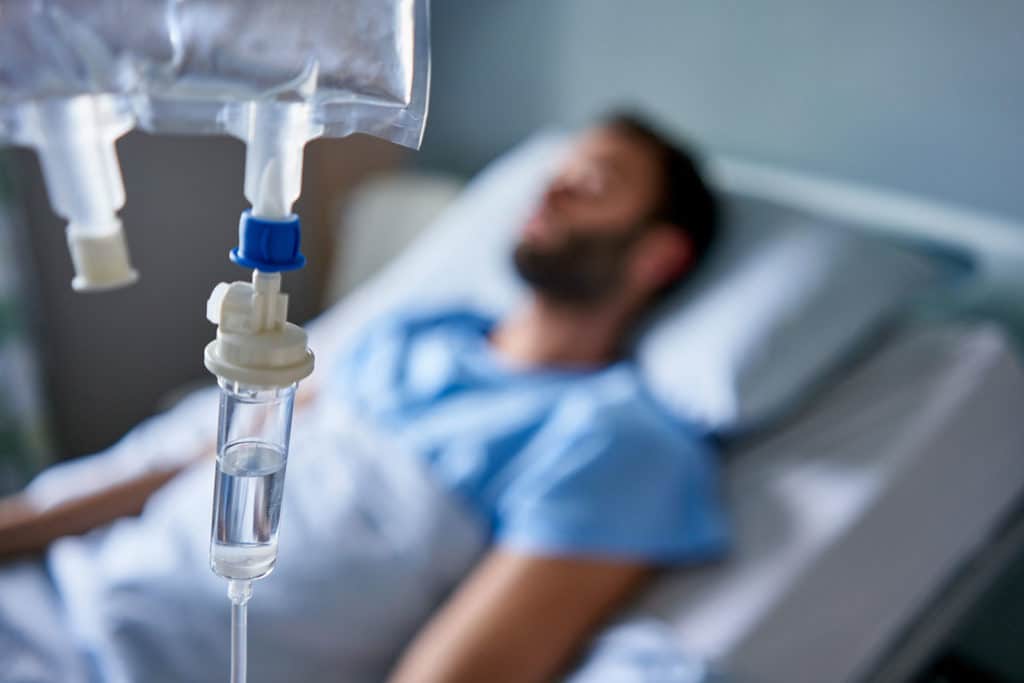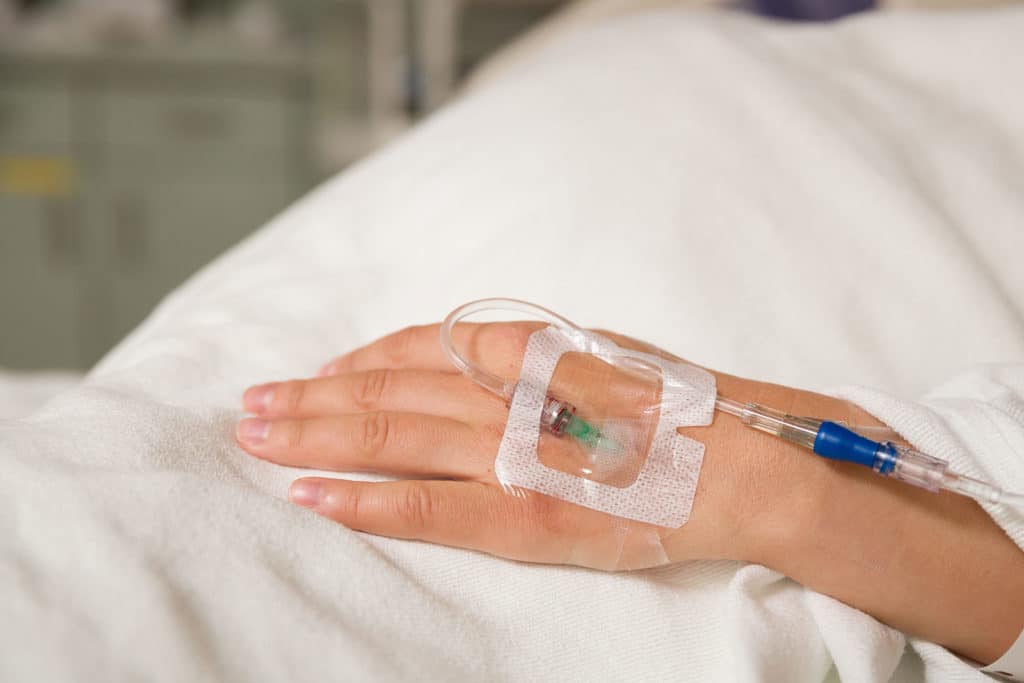There’s a lot that can go wrong with intravenous drug use.
The overdose risk increases because injected drugs work a lot faster. A nonsterile injection can introduce bacteria into your bloodstream. A blood clot could form in a deep vein.
You might also end up with a blown vein. What is it, and is it as serious as the others? Can a blown vein actually kill you?
This post will help you better understand, deal with, and prevent blown veins.
Table of Contents
- Defining the Nature of the Injury and Its Symptoms
- Concern Level and When to See a Doctor for a Blown Vein
- 3 Potential Complications to Expect With Blown Veins
- Dealing With a Blown Vein
- 3 Risk Factors During IV Injections
- 5 Tips for Avoiding Blown Veins
- Blown Vein vs. Collapsed Vein
- Final Thoughts
- Additional Resources
Defining the Nature of the Injury and Its Symptoms
Let’s start by explaining what a blown vein is and what it might look like on your arm/leg. If you’re already familiar with these details and just need to find out how serious it is, skip to the next section.

What’s a Blown Vein?
For the most part, when “blown vein” is mentioned in addiction/recovery circles, it means a vein that has ruptured during injection. And by “ruptured,” we mean that the needle has punctured through and through the blood vessel.
Under normal circumstances, the needle should pierce the vein walls on only one side. But if something goes wrong (more on the risk factors later), the needle might go through the near and the far walls of the vessel.
What Does It Look Like?
Blood starts leaking out of the ruptured vein, causing bruising and swelling around the injection site. This hematoma might also feel tender to the touch.
Concern Level and When to See a Doctor for a Blown Vein
Blown veins can’t be used again until they heal, which might take 10–12 days. However, they’re usually not a cause for concern—at least not until you spot some red flags.
Blown Vein Red Flags
Go to the hospital immediately if:
- You feel feverish.
- Pus or other types of drainage come out of the injection site.
- You’re having difficulty moving the affected limb.
- The blown vein is causing severe pain.
It’s also wise to have the area checked out if it’s been several weeks with little to no healing.
Fatal Types of Vein Damage
The sort of rapture that could be fatal is one that happens in varicose vein segments or esophageal varices. That’s when the internal bleeding is sudden and serious enough to be considered life-threatening.
For substance use disorder (SUD) patients, damage to the veins in the liver in cases of alcoholic hepatitis is also a serious concern.
But for this article, we’ll be focusing mainly on blown veins from IV injections.
3 Potential Complications to Expect With Blown Veins
Just because blown veins from drug injections are a minor type of vein damage doesn’t mean that the condition can’t get worse.
Here are some complications to keep in mind:
1. Infiltration
When the blown vein is hooked up to IV fluids, the fluids may leak from the vein and into the surrounding tissue. In this case, the area around the IV will swell, and the skin will look pale.
2. Extravasation
Extravasation happens when the drug that leaks from the blown vein is irritating. This could cause inflammation.
That said, this issue is more common with cancer patients on chemotherapy than it is with those who suffer from substance abuse disorders.
3. Collapse
Let’s just clarify that a blown vein isn’t the same as a collapsed vein. We’ll cover the differences later in the article.
For now, you need to know it’s possible for a blown vein to cave in and never bounce back.

Dealing With a Blown Vein
There is no medication or medical procedure that can reverse the damage right then and there. However, there are some vein treatment options intended to manage the symptoms and promote healing in the long term.
Basic Support From Healthcare Providers
If you’re in a supervised facility or harm reduction injection site, there will be healthcare professionals around.
Here’s what they might do to help you out:
- Remove the needle safely to avoid further complications.
- Apply pressure to the affected area.
- Clean the insertion site.
- Use ice packs to control the swelling and discoloration.
What You Can Do at Home
After the healthcare professionals tackle the blown vein, they might recommend that you rest as much as possible. You don’t want to expose the affected limb to any strenuous activity, after all.
It’s also wise to avoid using this injection site for the time being.
3 Risk Factors During IV Injections
We’ve covered how a blown vein happens when the needle punctures the vein wall twice and comes out the other side. But why would that happen in the first place?
Here are some factors that increase the odds of this happening:
1. Mobile/Rolling Veins
Veins don’t actually “roll.” Sometimes, however, veins shift ever so slightly when pressure is applied to them. When you try to stick a needle into one, it’ll move around and ruin your aim.
2. Poor Injection Technique
Veins should be entered in one swift motion at an angle of 30°. If the person doing the needle insertion does it at the wrong angle, they might blow the vein.
Choosing an unsuitable needle also increases the risk. Remember that needles come in different gauges and lengths. Pick one that’s too big, and rupturing the vessel becomes more likely.
3. Fragile Veins
Some veins are weaker than others. Plus, vessel walls can age and lose their elasticity over time. This makes them more vulnerable to damage during blood draws or IV injections.

5 Tips for Avoiding Blown Veins
It’s still best to avoid blowing any veins from the get-go. Here are some nifty tips to keep in mind:
1. Focusing on Hydration
Staying hydrated is a good piece of advice in general, but it’s even more important before blood draws or IV injections. When you’re well-hydrated, your veins are plump and easy to spot.
2. Anchoring the Vein
Some caregivers anchor veins by creating tension in the arm and placing a thumb (non-dominant hand) a couple of inches below the IV insertion site.
Others resort to the C-hold technique. That’s when you use the index and thumb (also non-dominant hand) to keep the skin above and below the injection area taut.
No matter which technique is used, proper hand hygiene before anchoring the vein and giving the injection is vital.
3. Choosing the Right Needle Size
To pick the best needle for the job, trained healthcare providers have to consider how deep, fragile, and narrow the vein is. If you’re untrained, don’t try doing it yourself.
4. Staying Calm
You want to avoid flinching or moving around when someone is trying to stick a needle in your veins. Talk to your caregiver a bit so you can relax before the actual attempt.
If it helps, look at the other side and focus on your breathing.
5. Taking the Time
You have to be patient when someone is giving you an IV injection. It might take time to find the best vein, disinfect the surrounding area, anchor the vein, and enter at the right angle.
Blown Vein vs. Collapsed Vein
Vein ruptures and collapse are among the venous injuries associated with drug abuse. They both render the vein unavailable for injections and blood tests for the time being as well. However, as we mentioned earlier, they’re not the same.
A collapsed vein happens when the walls cave in toward each other, restricting blood flow in the vessel. One reason why the walls might cave in in the first place is using the same injection site over and over again.
In fact, people with SUDs usually start with the veins in their arms. Then, they move to the hands, legs, and feet, looking for veins that are still viable. That’s why visible injection marks are a sign of IV drug abuse. After a while, the area gets inflamed, and scar tissue starts to form.
Note that collapses are common with drugs like cocaine.
| Blown Vein | Collapsed Vein | |
| Nature of the Injury | A through-and-through needle puncture | Internal lining swells or caves in |
| Visible Bruising | Yes | Not necessarily |
| Common Risk Factors | Poor injection techniques, fragile or rolling veins | Repeated injections in the same area, injecting irritating drugs |
Final Thoughts
If your vein blows, odds are it’ll heal on its own. The healing process might take time, though. You should seek medical attention immediately if there’s any pus, drainage fever, severe pain, or immobility.

And remember that just because a blown vein is a minor injury doesn’t mean injecting illicit drugs into your veins can’t be fatal. There’s still the risk of overdosing, getting a blood-borne infection (think hepatitis and HIV), or developing deep vein thrombosis.
So, if you (or a loved one) suffer from a substance use disorder that requires intravenous injections, don’t hesitate to reach out and get the help you need today.
Additional Resources
- American Addiction Centers: Health Risks and Dangers of IV Drug Use
- National Harm Reduction Coalition: Safer Injection Tips



